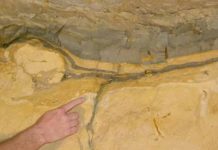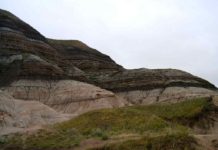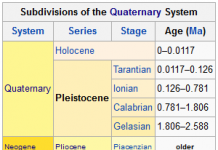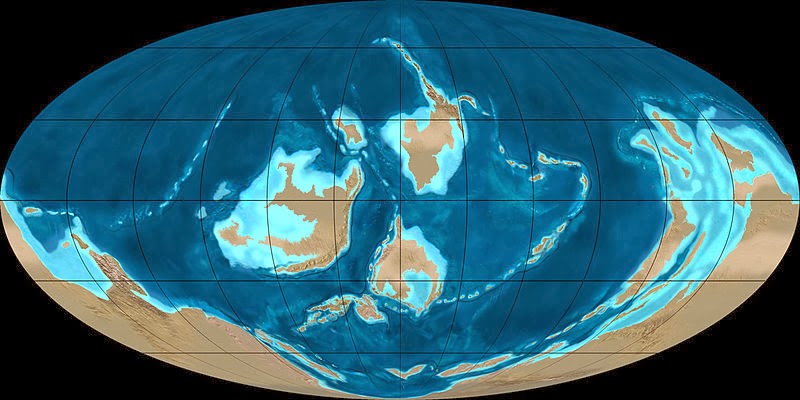
The Ordovician /ɔrdəˈvɪʃən/ is a geologic period and system, the second of six of the Paleozoic Era, and covers the time between 485.4 ± 1.9 to 443.4 ± 1.5 million years ago (ICS, 2004). It follows the Cambrian Period and is followed by the Silurian Period. The Ordovician, named after the Celtic tribe of the Ordovices, was defined by Charles Lapworth in 1879 to resolve a dispute between followers of Adam Sedgwick and Roderick Murchison, who were placing the same rock beds in northern Wales into the Cambrian and Silurian periods respectively.
Lapworth, recognizing that the fossil fauna in the disputed strata were different from those of either the Cambrian or the Silurian periods, realized that they should be placed in a period of their own. While recognition of the distinct Ordovician Period was slow in the United Kingdom, other areas of the world accepted it quickly. It received international sanction in 1960, when it was adopted as an official period of the Paleozoic Era by the International Geological Congress.Life continued to flourish during the Ordovician as it did in the Cambrian, although the end of the period was marked by a significant mass extinction. Invertebrates, namely mollusks and arthropods, dominated the oceans. Fish, the world’s first true vertebrates, continued to evolve, and those with jaws may have first appeared late in the period. Life had yet to diversify on land.
Extinction events
- Ordovician-Silurian extinction event- occurred at the end of the period approximately 443 million years ago. 60% of marine genera went extinct. The cause of the extinction was predicted to be a gamma-ray burst.
- Cambrian-Ordovician extinction event- occurred at the start of the period 485 million years ago.
Dating
The Ordovician Period started at a major extinction event called the Cambrian–Ordovician extinction events about 485.4 ± 1.9 Mya (million years ago), and lasted for about 44.6 million years. It ended with the Ordovician–Silurian extinction event, about 443.4 ± 1.5 Mya (ICS, 2004) that wiped out 60% of marine genera.
The dates given are recent radiometric dates and vary slightly from those used in other sources. This second period of the Paleozoic era created abundant fossils and in some regions, major petroleum and gas reservoirs.
The boundary chosen for the beginning both of the Ordovician Period and the Tremadocian stage is highly useful. Since it correlates well with the occurrence of widespread graptolite, conodont, and trilobite species, the base of the Tremadocian allows scientists not only to relate these species to each other, but to species that occur with them in other areas as well. This makes it easier to place many more species in time relative to the beginning of the Ordovician Period.
Subdivisions
A number of regional terms have been used to refer to subdivisions of the Ordovician Period. In 2008, the ICS erected a formal international system of subdivisions, illustrated to the right.
The Ordovician Period in Britain was traditionally broken into Early (Tremadocian and Arenig), Middle (Llanvirn [subdivided into Abereiddian and Llandeilian] and Llandeilo) and Late (Caradoc and Ashgill) epochs. The corresponding rocks of the Ordovician System are referred to as coming from the Lower, Middle, or Upper part of the column. The faunal stages (subdivisions of epochs) from youngest to oldest are:
Late Ordovician
- Hirnantian/Gamach (Ashgill)
- Rawtheyan/Richmond (Ashgill)
- Cautleyan/Richmond (Ashgill)
- Pusgillian/Maysville/Richmond (Ashgill)
- Trenton (Caradoc)
- Onnian/Maysville/Eden (Caradoc)
- Actonian/Eden (Caradoc)
- Marshbrookian/Sherman (Caradoc)
- Longvillian/Sherman (Caradoc)
- Soudleyan/Kirkfield (Caradoc)
- Harnagian/Rockland (Caradoc)
- Costonian/Black River (Caradoc)
- Chazy (Llandeilo)
- Llandeilo (Llandeilo)
- Whiterock (Llanvirn)
- Llanvirn (Llanvirn)
- Cassinian (Arenig)
- Arenig/Jefferson/Castleman (Arenig)
- Tremadoc/Deming/Gaconadian (Tremadoc)
British stages
Paleogeography
Sea levels were high during the Ordovician; in fact during the Tremadocian, marine transgressions worldwide were the greatest for which evidence is preserved in the rocks.
During the Ordovician, the southern continents were collected into a single continent called Gondwana. Gondwana started the period in equatorial latitudes and, as the period progressed, drifted toward the South Pole. Early in the Ordovician, the continents Laurentia (present-day North America), Siberia, and Baltica (present-day northern Europe) were still independent continents (since the break-up of the supercontinent Pannotia earlier), but Baltica began to move towards Laurentia later in the period, causing the Iapetus Ocean to shrink between them. The small continent Avalonia separated from Gondwana and began to head north towards Baltica and Laurentia. The Rheic Ocean between Gondwana and Avalonia was formed as a result.
A major mountain-building episode was the Taconic orogeny that was well under way in Cambrian times. In the beginning of the Late Ordovician, from 460 to 450 Ma, volcanoes along the margin of the Iapetus Ocean spewed massive amounts of carbon dioxide into the atmosphere, turning the planet into a hothouse. These volcanic island arcs eventually collided with proto North America to form the Appalachian mountains. By the end of the Late Ordovician these volcanic emissions had stopped. Gondwana had by that time neared or approached the pole and was largely glaciated.
Ordovician meteor event
Geochemistry
The Ordovician was a time of calcite sea geochemistry in which low-magnesium calcite was the primary inorganic marine precipitate of calcium carbonate. Carbonate hardgrounds were thus very common, along with calcitic ooids, calcitic cements, and invertebrate faunas with dominantly calcitic skeletons.
Unlike Cambrian times, when calcite production was dominated by microbial and non-biological processes, animals (and macroalgae) became a dominant source of calcareous material in Ordovician deposits.
Climate and sea level
The Ordovician saw the highest sea levels of the Paleozoic, and the low relief of the continents led to many shelf deposits being formed under hundreds of metres of water. Sea level rose more or less continuously throughout the Early Ordovician, levelling off somewhat during the middle of the period. Locally, some regressions occurred, but sea level rise continued in the beginning of the Late Ordovician. A change was soon on the cards, however, and sea levels fell steadily in accord with the cooling temperatures for the ~30 million years leading up to the Hirnantian glaciation. Within this icy stage, sea level seems to have risen and dropped somewhat, but despite much study the details remain unresolved.
At the beginning of the period, around 485.4 ± 1.9 million years ago, the climate was very hot due to high levels of CO2, which gave a strong greenhouse effect. The marine waters are assumed to have been around 45°C (113°F), which restricted the diversification of complex multi-cellular organisms. But over time, the climate became cooler, and around 460 million years ago, the ocean temperatures became comparable to those of present day equatorial waters.
As with North America and Europe, Gondwana was largely covered with shallow seas during the Ordovician. Shallow clear waters over continental shelves encouraged the growth of organisms that deposit calcium carbonates in their shells and hard parts. The Panthalassic Ocean covered much of the northern hemisphere, and other minor oceans included Proto-Tethys, Paleo-Tethys, Khanty Ocean, which was closed off by the Late Ordovician, Iapetus Ocean, and the new Rheic Ocean.
As the Ordovician progressed, we see evidence of glaciers on the land we now know as Africa and South America. At the time these land masses were sitting at the South Pole, and covered by ice caps.
Life
Fauna
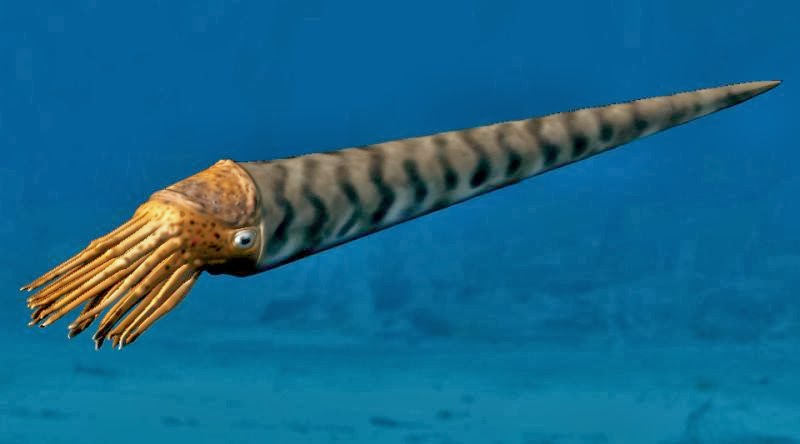
On the whole, the fauna that emerged in the Ordovician set the template for the remainder of the Palaeozoic. The fauna was dominated by tiered communities of suspension feeders, mainly with short food chains; this said, the ecological system reached a new grade of complexity far beyond that of the Cambrian fauna, which has persisted until the present day.
Though less famous than the Cambrian explosion, the Ordovician featured an adaptive radiation, the Ordovician radiation, that was no less remarkable; marine faunal genera increased fourfold, resulting in 12% of all known Phanerozoic marine fauna. Another change in the fauna was the strong increase in filter feeding organisms. The trilobite, inarticulate brachiopod, archaeocyathid, and eocrinoid faunas of the Cambrian were succeeded by those that dominated the rest of the Paleozoic, such as articulate brachiopods, cephalopods, and crinoids. Articulate brachiopods, in particular, largely replaced trilobites in shelf communities. Their success epitomizes the greatly increased diversity of carbonate shell-secreting organisms in the Ordovician compared to the Cambrian.
In North America and Europe, the Ordovician was a time of shallow continental seas rich in life. Trilobites and brachiopods in particular were rich and diverse. Although solitary corals date back to at least the Cambrian, reef-forming corals appeared in the early Ordovician, corresponding to an increase in the stability of carbonate and thus a new abundance of calcifying animals.
Molluscs, which appeared during the Cambrian or even the Ediacaran, became common and varied, especially bivalves, gastropods, and nautiloid cephalopods.
Now-extinct marine animals called graptolites thrived in the oceans. Some new cystoids and crinoids appeared.
It was long thought that the first true vertebrates (fish — Ostracoderms) appeared in the Ordovician, but recent discoveries in China reveal that they probably originated in the Early Cambrian. The very first gnathostome (jawed fish) appeared in the Late Ordovician epoch.
During the Middle Ordovician there was a large increase in the intensity and diversity of bioeroding organisms. This is known as the Ordovician Bioerosion Revolution. It is marked by a sudden abundance of hard substrate trace fossils such as Trypanites, Palaeosabella and Petroxestes.
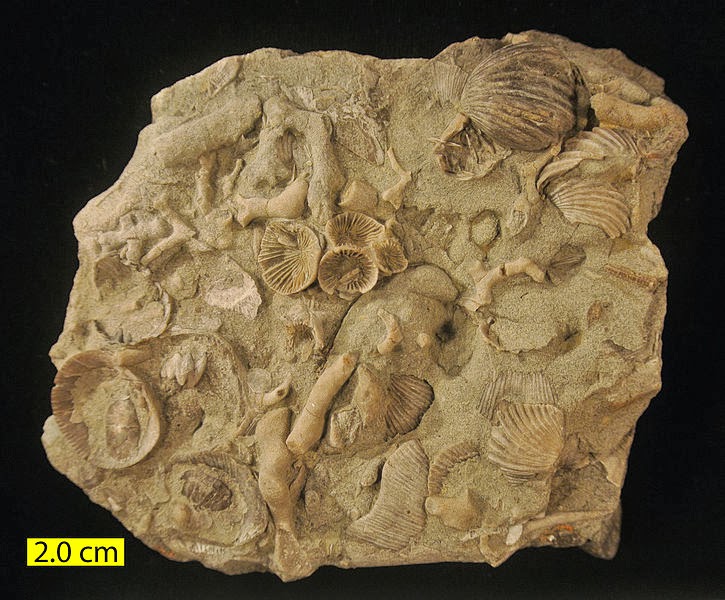
In the Early Ordovician, trilobites were joined by many new types of organisms, including tabulate corals, strophomenid, rhynchonellid, and many new orthid brachiopods, bryozoans, planktonic graptolites and conodonts, and many types of molluscs and echinoderms, including the ophiuroids (“brittle stars”) and the first sea stars. Nevertheless the trilobites remained abundant, with all the Late Cambrian orders continuing, and being joined by the new group Phacopida. The first evidence of land plants also appeared; see Evolutionary history of life.
In the Middle Ordovician, the trilobite-dominated Early Ordovician communities were replaced by generally more mixed ecosystems, in which brachiopods, bryozoans, molluscs, cornulitids, tentaculitids and echinoderms all flourished, tabulate corals diversified and the first rugose corals appeared; trilobites were no longer predominant. The planktonic graptolites remained diverse, with the Diplograptina making their appearance. Bioerosion became an important process, particularly in the thick calcitic skeletons of corals, bryozoans and brachiopods, and on the extensive carbonate hardgrounds that appear in abundance at this time. One of the earliest known armoured agnathan (“ostracoderm”) vertebrate, Arandaspis, dates from the Middle Ordovician.
Trilobites in the Ordovician were very different from their predecessors in the Cambrian. Many trilobites developed bizarre spines and nodules to defend against predators such as primitive sharks and nautiloids while other trilobites such as Aeglina prisca evolved to become swimming forms. Some trilobites even developed shovel-like snouts for ploughing through muddy sea bottoms. Another unusual clade of trilobites known as the trinucleids developed a broad pitted margin around their head shields. Some trilobites such as Asaphus kowalewski evolved long eyestalks to assist in detecting predators whereas other trilobite eyes in contrast disappeared completely.
Flora
Green algae were common in the Late Cambrian (perhaps earlier) and in the Ordovician. Terrestrial plants probably evolved from green algae, first appearing as tiny non-vascular forms resembling liverworts. Fossil spores from land plants have been identified in uppermost Ordovician sediments. The green algae were similar to today’s sea moss.Colonization of land would have been limited to shorelines
Among the first land fungi may have been arbuscular mycorrhiza fungi (Glomerales), playing a crucial role in facilitating the colonization of land by plants through mycorrhizal symbiosis, which makes mineral nutrients available to plant cells; such fossilized fungal hyphae and spores from the Ordovician of Wisconsin have been found with an age of about 460 million years ago, a time when the land flora most likely only consisted of plants similar to non-vascular bryophytes.
End of the period
The Ordovician came to a close in a series of extinction events that, taken together, comprise the second largest of the five major extinction events in Earth’s history in terms of percentage of genera that went extinct. The only larger one was the Permian-Triassic extinction event.
The extinctions occurred approximately 447–444 million years ago and mark the boundary between the Ordovician and the following Silurian Period. At that time all complex multicellular organisms lived in the sea, and about 49% of genera of fauna disappeared forever; brachiopods and bryozoans were greatly reduced, along with many trilobite, conodont and graptolite families.
The most commonly accepted theory is that these events were triggered by the onset of most cold conditions in the late Katian, followed by an ice age, in the Hirnantian faunal stage, that ended the long, stable greenhouse conditions typical of the Ordovician.
The ice age was possibly not long-lasting, study of oxygen isotopes in fossil brachiopods showing that its duration could have been only 0.5 to 1.5 million years. Other researchers (Page et al.) estimate more temperate conditions did not return until the late Silurian.
The late Ordovician glaciation event was preceded by a fall in atmospheric carbon dioxide (from 7000 ppm to 4400 ppm), which selectively affected the shallow seas where most organisms lived. As the southern supercontinent Gondwana drifted over the South Pole, ice caps formed on it, which have been detected in Upper Ordovician rock strata of North Africa and then-adjacent northeastern South America, which were south-polar locations at the time.
Glaciation locks up water from the world-ocean, and the interglacials free it, causing sea levels repeatedly to drop and rise; the vast shallow intra-continental Ordovician seas withdrew, which eliminated many ecological niches, then returned carrying diminished founder populations lacking many whole families of organisms, then withdrew again with the next pulse of glaciation, eliminating biological diversity at each change.Species limited to a single epicontinental sea on a given landmass were severely affected. Tropical lifeforms were hit particularly hard in the first wave of extinction, while cool-water species were hit worst in the second pulse.
Surviving species were those that coped with the changed conditions and filled the ecological niches left by the extinctions.
At the end of the second event, melting glaciers caused the sea level to rise and stabilise once more. The rebound of life’s diversity with the permanent re-flooding of continental shelves at the onset of the Silurian saw increased biodiversity within the surviving Orders.
Melott et al. (2004) suggested a ten-second gamma ray burst could have destroyed the ozone layer and exposed terrestrial and marine surface-dwelling life to deadly radiation and initiated global cooling.


